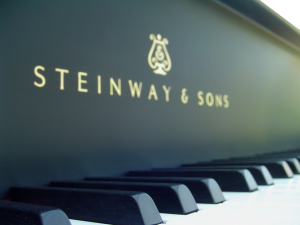 Piano refinishing is a specialty profession that requires years of experience and professional equipment. The standards are extremely high: in the furniture industry, the best finish you can get (and also the most expensive) is usually called a “piano grade” finish. It is a tremendous amount of work, requiring complete stripping and removal of all the old coats of finish, then painstakingly building back up all the layers of stain, filler, sealer, and final coats, and sanding in-between. There is frequently woodworking and repair that needs to be done as well, to repair damaged or worn case parts. Many rebuilders and technicians do not do refinishing for this very reason. For one thing, in a typical grand or large upright, there are an awful lot of square feet to strip and refinish. If you think a piano takes up a lot of room assembled, you should see how much additional space it requires when taken apart!
Piano refinishing is a specialty profession that requires years of experience and professional equipment. The standards are extremely high: in the furniture industry, the best finish you can get (and also the most expensive) is usually called a “piano grade” finish. It is a tremendous amount of work, requiring complete stripping and removal of all the old coats of finish, then painstakingly building back up all the layers of stain, filler, sealer, and final coats, and sanding in-between. There is frequently woodworking and repair that needs to be done as well, to repair damaged or worn case parts. Many rebuilders and technicians do not do refinishing for this very reason. For one thing, in a typical grand or large upright, there are an awful lot of square feet to strip and refinish. If you think a piano takes up a lot of room assembled, you should see how much additional space it requires when taken apart!
Often piano owners, though, without adequate knowledge or experience, will attempt to refinish their piano themselves, and end up with either a mess, or else a very unprofessional-looking job. Those unfortunate enough to have bought a piano refinished by such a person are usually in for a host of unpleasant surprises when they get the piano home, anything from the finish turning gummy or sticky, or discoloring, or cracking, or bubbling, to even falling off in large flakes and chunks.
Pianos that originally had a wood-grain, (or clear) finish are often painted black, and pianos that should have been left black (or ebony) are refinished wood-grain, often with disastrous results. Other pianos are “antiqued,” (painted to make them look like “heirlooms,” usually in a range of pastel colors ranging from beige to light blue or green, and usually with gold trim) -which lowers their value. Beautiful old uprights often had their cabinets altered, modified, or “chopped down” in a futile attempt to make them look like smaller pianos, with the addition of mirrors and other alterations that make it difficult or impossible for the tuner to subsequently service them. And unless you have a trained eye, and a good deal of experience, poor quality or incompetent refinishing can not always be easily spotted.
Article Source: http://www.pianofinders.com/educational/shortguide.htm
